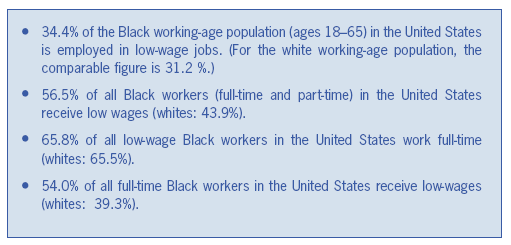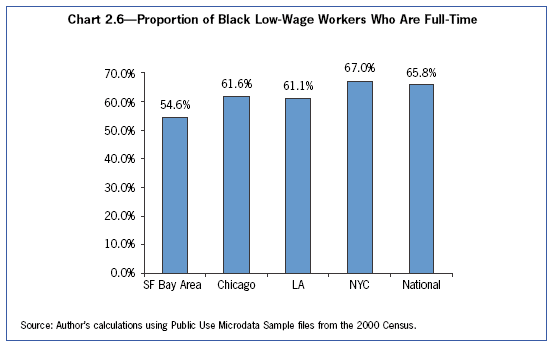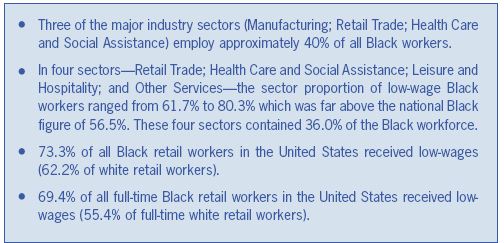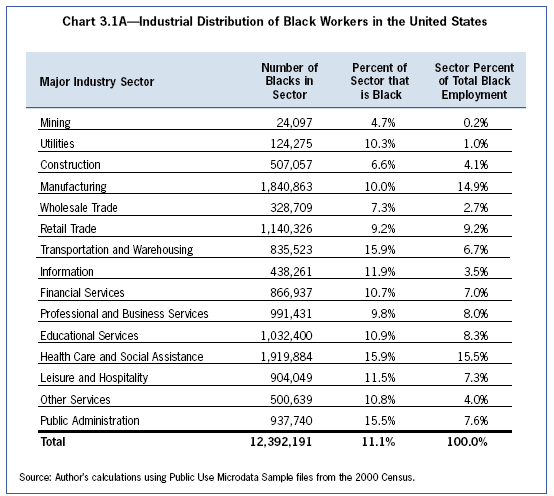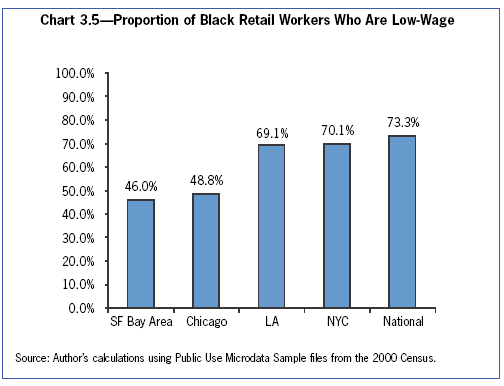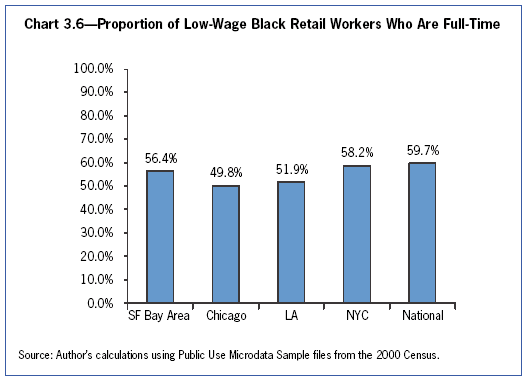
|
|||||||||||||||||||||
|
||||||||||
|
||||||||||
 |
||||||||||
Cover photo by Steve Cagan The Center for Labor Research and Education, UC Berkeley is an affiliate of the University of California Miguel Contreras Labor Program This research was funded by grants received from the Akonadi Foundation and the Arca Foundation. The project was completed with the assistance of Hannah Betesh and Ginny Fang. Click here to view the full report in printer friendly PDF format. Click here to view an Executive Summary of the report. CHAPTER ONE:INTRODUCTION: THE INVISIBILITY OF THE BLACK WORKING POORSince the end of slavery, visionaries within the Black community, including Ida B. Wells, W.E.B. DuBois, and Paul Robeson, have led a freedom movement with the dual objectives of eliminating racial inequality and improving the quality of life for Blacks in the United States. Beginning in the mid-1950s with the Brown v. Board of Education Supreme Court decision and the Montgomery Bus Boycott, this struggle took the form of the modern civil rights movement. The activities of millions of people in that movement brought about the end ofde jure segregation in the United States and opened up new opportunities for African Americans. The hope was that the end of legal barriers to advancement and the enactment of policies to redress historic racial injustices would result in a qualitative change in life out-comes for Blacks in this country. Thirty-five years have passed since the victories of the modern civil rights movement, and we have entered into a new era, one marked by a radically different global economic and political context. This report, "Job Quality and Black Workers: An Examination of the San Francisco Bay Area, Los Angeles, Chicago, and New York," looks at one sphere of Black life, the labor market,and takes stock of the realities for Black workers in the context of 21st century globalization. It presents a detailed view of the Black workforce with a focus on the incidence of low-wage work. To the extent African Americans experience a high incidence of low-wage work and many of these jobs will exist in the near-term future, this situation speaks to the need for renewed efforts at transforming the low-wage labor market in order to improve the opportunities available to Black workers. The research presented in this report lead to three important conclusions. First, the Black community in the United States faces a two-dimensional crisis concerning employment: the crisis of unemployment and the crisis of low-wage jobs. The crisis of unemployment is the typical face of the jobs problem among African Americans. In the popular media, the unemployment crisis is captured by scenes of approximately 11,000 applicants, largely Black and Latino, lining up for 400 vacancies at an Oakland Wal-Mart. However, this scene portrays only one part of the employment dilemma facing African Americans. The other serious problem is the crisis of low-wage jobs held by Blacks who have employment. Too many African Americans work at jobs that do not provide wages (and benefits) to properly raise a family. The purpose of this research project is to gain a deeper understanding of the fate of Blacks who have jobs. The inattention to the crisis of low-wage jobs reflects the invisibility of the Black working poor. This invisibility is startling given that every day Blacks go to work. They drive buses throughout U.S. cities. They work in schools as teachers, clerical staff, and maintenance workers. They care for small children, disabled adults and the elderly. Some Blacks repair electrical lines or work in hospitals. Blacks unload the ships at our ports and move containers to inland warehouses. Others drive trucks carrying goods from these warehouses to the stores in which we shop. Some Blacks ring up sales in these stores while others provide security at these stores and office buildings. Black people work. However, many of these jobs are bad jobs that do not allow for a decent quality of life. The jobs don't pay well. They don't provide retirement and health benefits. The jobs are "dead-end" jobs inasmuch as they do not link to better jobs either within the firm or at other businesses. Many of the jobs held by Black workers don't provide on-the-job protection from employers' arbitrary decisions: a protection that comes from the presence of a union. As a result, many workers are forced to work multiple jobs in order to buy essential goods and services. Others are forced to choose between food and prescription drugs, between gasoline and decent child care, or between decent housing and college for their kids. The living standards for these workers and their families suffer as a result. A second key conclusion of the research is that the incidence of low-wage Black employment is concentrated in certain key industry sectors. Among all Black workers, 56.5% work for low-wages; however, the four sectors where the percentage of low-wage Black employment exceeds 60%, Retail Trade; Health Care and Social Assistance; Leisure and Hospitality; and Other Services, contain approximately one-third of all Black workers. Thus, any set of strategies which seek to improve job quality for Black workers must address these sectors which hire a significant number of Black workers and pay poorly. Finally, the research begins to outline how new global economic realities are having an impact on future employment prospects for Black workers. In contrast to popular perception, these realities go beyond job flight from the United States offshoring, to encompass the expansion of industries that are more rooted in this country. Data reveals that Blacks have a significant presence in those industries which are more place-based with less vulnerability to offshoring. Many of these same industries have been projected as growth industries and many employ high numbers of low-wage Black workers. These facts imply that strategies to address the job crisis must look at these industries which will do well in the new global economy and find ways to transform the job quality in these industries. Simply relying on job training programs to address the crisis surrounding employment outcomes will miss a significant portion of the crisis. These conclusions point to the need for a multi-faceted approach to solve the job crisis in the Black community: an approach which addresses the issue of low-wage work, the issue of unemployment, and the need for regional economic development policies while simultaneously seeking economic growth and equity. Fighting the crisis of unemployment requires substantive programs which lower the barriers to job access. These barriers are individual and structural, and both types of barriers must be attacked in order to expand employment opportunities. However, programs designed to increase employment opportunities for African Americans will have limited value on the scale which is needed if a large portion of jobs which are created are low-wage jobs. These low-wage jobs need to be transformed into better quality jobs. Thus, the fight for job access must be intertwined with the fight for job transformation. The neglect of the plight of the Black working poor and the exclusive focus on the plight of the Black jobless frames issues and shifts resources into a search for any job regardless of the quality of that job. Some community advocates, citing the need for jobs and retail shopping opportunities, support economic development plans which target the retail sector in an attempt to either revitalize downtown districts or generate tax revenue. However, the entry of stores such as Wal-Mart results in employment at low wages with little or no benefits. Thus, the presence of Wal-Mart in central city communities reflects a perceived Hobson's Choice between no jobs or low-wage jobs. The dilemma of no jobs or low-wage jobs reflects the dominance of "low road" economic development policies. These policies seek to attract businesses to regions and cities regardless of the quality of jobs they offer residents. When jurisdictions travel the "low road," they follow a path that fosters intense competition between cities for tax bases and a vicious race to the bottom: local governments offer higher and higher subsidies that actually lower the net benefits of the firm's presence in a region. The proliferation of these policies has created an atmosphere such that any efforts to mitigate the negative impacts of new firms or create labor standards are decried by many local leaders as antithetical to the economic health of the region. The path of "low road" economic development assists in the growth of a low-wage economy. What is needed is to go "beyond Wal-Mart" to identify public policies that raise labor standards and transform bad jobs as well as reduce the high levels of unemployment. Such new public policies would attempt to block the low-road path toward economic development, while simultaneously building a high road alternative. They would include minimum wage, living wage, and industry wage laws that establish wage floors in regional labor markets. They would include "clawback" policies so that any firms receiving government subsidies would be required to return a portion or all of these benefits if they did not fulfill promises surrounding job creation. They would include community benefits agreements designed to ensure that low-income neighborhoods and their residents benefit from economic developent. They would include linked workforce and economic development programs with incentives to place local residents on pathways to well-paying jobs and that seek to develop those sectors of the local economy which provide a possibility for decent jobs. The net result of these policies would be a regional economy that grows and is equitable. What is also needed are policies designed to empower poor communities and their residents in economic decision-making. Public policies are a result of political compromise and relative political power; if poor communities do not have substantial power, local economic development policies will generate few gains for poor people. Foremost are policies that will allow workers to organize on their own behalf without the interference of employers. Union representation is an indispensable weapon for low-wage workers who seek to raise the quality of the jobs they hold. However, in the past thirty years, the right to organize has been under attack as deliberate efforts by businesses combined with government regulatory neglect and rapid changes in the structure of the economy have resulted in lowest levels of unionization since the Great Depression. The impact of the loss of effective workplace collective action includes lower living standards and the loss of dignity on the job. Chapter Two of this report presents the key terms used throughout this report. It then presents a portrait of the Black working age population in 2000. The chapter concludes by demonstrating the prevalence of low-wage jobs among Black workers. Chapter Three looks at the industrial distribution of Black workers and finds industry sectors with significant concentrations of Black workers. In addition, many industry sectors have high proportions of low-wage workers among their Black workforce. The chapter takes a closer look at the retail industry because of recent highly charged racialized debates that have pitted advocates of stronger labor standards against advocates of unfettered retail economic development. Chapter Four places the issue of Black workers and job quality in the context of globalization and finds that large numbers of low-wage Black workers are in industries that do not face an immediate threat of offshoring. Chapter Five summarizes these findings and presents research and policy recommendations. CHAPTER TWO:LOW-WAGE EMPLOYMENT AND BLACK WORKERS Chapter OverviewThis chapter presents basic data on the incidence of low-wage work in the Black working-age population.v It begins by defining the key terms used throughout this report and proceeds to an overview of the Black working-age population in the United States as a nation and then in the San Francisco Bay Area, Los Angeles, Chicago, and New York. It then presents data on the persistence of low-wage work among Black workers. The data indicates that low-wage workers are a significant portion of Black population between 18 and 65 years of age. In addition, narrowing the analysis to those members of the Black working age population who work, a high percentage of Black workers receive low wages. Finally, in contrast to many popular pronouncements that present low-wage work as a part-time phenomenon, a large segment of the low-wage Black workforce works full-time. Some key findings in this chapter are:
Key Terms and DefinitionsThis report expands on previous research done on the San Francisco-Oakland-San Jose metropolitan area, by exploring the incidence of low-wage work among Black workers in the Los Angeles, Chicago and New York metropolitan areas. These metropolitan areas were chosen because they represent the three largest concentrations of Blacks in the United States. Chart 2.1 presents the county definitions of the targeted metropolitan areas. In addition to the information on the metropolitan areas, data is presented on the Black workers in the United States as a whole. While this study focuses on Black workers, for purposes of comparison, data will be presented on other racial/ethnic groupings as well.
The quality of a job can be measured by several dimensions. Most obvious is the wage the job provides. Other criteria include: the availability of retirement, health care, and other non-monetary benefits; the safety environment in the workplace; the degree to which the structure of the job allows workers the flexibility to tend to family needs; any linkages to better jobs either within the firm or with other businesses; and the presence of due process procedures in the face of the arbitrary use of employer authority. Many commentators have expressed concern over the large number of bad jobs created by the U.S. economy in recent years. A bad job can be defined as possessing some combination of the following characteristics:
This report will focus on the wage dimension of job quality. For our purposes, we define a low-wage job in 1999 to be a job that paid a wage less than or equal to twice the 1970 minimum wage adjusted for inflation.viii In 1970, the federal minimum wage was 47% of the average wage for non-supervisory workers in the private sector; in 2000, this share fell to 37%. (By 2006, the share had fallen even further to 31%.) Hence the use of an inflation-adjusted 1970 minimum wage threshold for low-wage work implies the use of a threshold that would exist if the real value of the 1970 minimum wage been maintained. As footnoted earlier, the sources for much of this data are the individual responses to the 2000 Census contained in the Public Use Microdata Set (PUMS). The questions were asked of respondents during the 2000 year; however, the central questions used to determine wages and work status asks about the respondents' behavior in 1999. Hence, all data reflects the events of 1999.ix Chart 2.2 presents the wage thresholds used in this report.
Other important definitions are: WORKING AGE POPULATION: All persons between 18-65 years of age (inclusive). LABOR FORCE: All persons who have had some paid employment or, if they have not, have been seeking employment. WORK STATUS:
WORKER: All persons whose work status was either full-time or part-time. A note on the categories: did not work last year, irregular work, and low-wage work. The nature of various census questions did not allow for a straight-forward comparison between low-wage workers and unemployed individuals. (The questions used to define "low-wage" asked about labor market activity in 1999; the question about unemployed status asked about labor market activity in 2000.) Hence, the answer to the question, "did you work last year" was utilized as a proxy for the question concerning unemployment. Both of these terms are problematic as researchers attempt to align answers to census questions with public perception of real behavior. The term, "unemployed" refers only to those persons who were seeking employment but did not find employment. By definition, this term is too narrow as it ignores those who are jobless but have dropped out of the labor force because they are discouraged and feel that any job search would be fruitless. However, the term "did not work last year" is too broad because it includes some individuals who voluntarily are not seeking employment (e.g. students, homemakers). With respect to the term "irregular" , those individuals who worked less than half of the year (less than 1000 hours) had a significant detachment from the labor market and consequently, it would be improper to classify as workers with individuals who had significantly more work activity. A better match of these individuals was with those individuals who did not work during the survey year. An Overview of the Black Working-Age PopulationCharts 2.3A through 2.3E present 2000 data on distribution of the Black working age population across four categories: full-time work; part-time work; irregular work; and didn't work last year. In the United States, 60.8% of the Black working-age population was working either full-time or part-time in 1999. In the four regions, this proportion ranged from 61.3% in the San Francisco Bay Area to 55.5% in New York. Twenty-six percent of the Black working-age population in the United States did not work in 1999; this proportion ranged from 25.7% (San Francisco Bay Area) to 32.1% (New York) in the four regions. (By way of comparison, 17.8% of the white working-age population in the United States did not work in 1999; see Chart A1 in the appendix.)
The Crisis of Low-Wage Work in the Black CommunityThe data indicates two components of the crisis of low-wage work. First, a significant segment of the Black working age population works for low-wages. Second, just looking at Black workers, a set of people smaller than number of people in the working age population, the research reveals that a large share of Black workers receive low-wages. Using the thresholds for low-wage work, the data in the previous section can be re-organized to illustrate the first component of the crisis of low-wage work in the Black community. Charts 2.4A through 2.4E present this re-organized data. In these charts, full-time and part-time workers have been re-categorized as low-wage and non low-wage workers; in addition, individuals who were irregular workers or did not work in 1999 have been grouped together. During that year, one-third of the Black working-age population in the United States held low-wage jobs. In the four regions, this proportion varied from 17.2% in the Bay Area to 28.9% in Los Angeles. (The comparable figure for the white population in the United States was 31.2 %; see Chart A2 in the appendix.)
The second component of the low-wage work crisis is the high propensity for Black workers to earn low wages. Charts 2.5 through 2.7 focus on workers and ignore that segment of the working-age population that did not work or worked irregularly. As Chart 2.5 indicates, 56.5% of all Black workers (full-time and part-time) in the United States were employed in low-wage jobs. This proportion was similar to what existed in Los Angeles, Chicago, and New York City; the low-wage share of Black workers was significantly lower in the San Francisco Bay Area.
Often, the source of low-wage work is claimed to be the prevalence of part-time work. Chart 2.6 indicates that low-wage work is not just a part-time work phenomenon. Two-thirds of all low-wage Black workers in the United States (65.8%) work full-time. This proportion ranges from 54.6% (the San Francisco Bay Area) to 67% (New York City) in the four regions.
Chart 2.7 presents this information in a different way. Here, the focus of examination is just full-time Black workers. The data indicates that 54% of full-time Black workers work for low wages. 
ConclusionThe dominant portrayal of the jobs crisis in the Black community depicts the high incidence of unemployment. This chapter presents a fuller portrait of the jobs crisis by demonstrating that in the working age population the incidence of low wages nearly matches the incidence of joblessness. In addition, the phenomenon of low-wage is prevalent among full-time Black workers. These realities indicate the need to go beyond policy prescriptions that are limited to addressing unemployment in order to include policies to reduce the incidence of low-wage work. CHAPTER THREE:THE INDUSTRIAL DISTRIBUTION OF BLACK EMPLOYMENT Chapter OverviewThis chapter presents data on the major industry sectors that employ Black workers in the nation and in the four metropolitan areas analyzed in this report. It finds significant concentrations of Black workers in particular industries and significant levels of low-wage work in certain sectors. The chapter then explores the retail industry more closely because that sector has been the site of major policy fights, as some advocates seek to maintain labor standards in the industry while others promote growth in that sector despite any impact on wages. The chapter finds many that Blacks work in retail and therefore any negative impacts on wages for all retail workers due to the uncontrolled entry of large retailers to a metropolitan area will have an impact on Black workers. Some key findings in this chapter are:
Why Examine the Industrial Distribution of EmploymentIt is important to present data on industry because the employment prospects for workers, and hence, their prospects for earning potential, partially are shaped by the structure of the industries that are hiring. Without the demand for labor on the part of firms that are offering livable wages, it will be increasing difficult for job seekers to find employment that allows them to raise their families at decent living standards. As the industrial structure of the economy changes, measured by the level of employment in each industry; the distribution of jobs across different industries; and the wages paid by these industries, so will change the prospects for jobs that pay well. It is also important to examine industries because most strategies designed to improve job quality by affecting the behavior of firms (in contrast to affecting the behavior of individuals) will target industries. Economic development policies can attract low-wage or high-wage industries. Policies to raise labor standards and raise enforcement of existing labor laws can be tailored to industries. Another key strategy to improve the quality of existing jobs is unionization, and most unions attempt to organize workers based on firms and industries. Where are Black Workers Concentrated?Chart 3.1A presents the distribution of Black workers in the United States across the 15 major non-farm industry sectors. Three of the sectors (Manufacturing; Retail Trade; Health Care and Social Assistance) employ approximately 40% of all Black workers. Examining the nation's workforce as a whole, Blacks comprise 11.1% of workers. Three sectors are disproportionately Black: Transportation; Health Care and Social Assistance; and Public Administration. Blacks are significantly underrepresented in three sectors: Mining; Construction; and Wholesale Trade. In the remaining nine industry sectors, the proportion of Black workers present is within 1.9% of the workforce average.
Charts A3 through A6 in the appendix present the data on the distribution of Black workers and low-wage Black work across the four regions. As mentioned in Chapter 2, there is a variation in the proportion of Black workers holding low-wage jobs. In addition, the key industries for Black employment vary in each metropolitan area. Chart 3.1B provides data on the top five industries for Black employment in each region. These sectors capture between 54.1% (the San Francisco Bay Area) and 59.5% (New York) of all Black workers. While Health Care and Social Assistance, Professional and Business Services, and Transportation are among the top five in each area, other ranking sectors are Retail Trade (Los Angeles; the Bay Area); Financial Services (New York; Chicago); Educational Services (Los Angeles; New York); and Manufacturing (Chicago; the Bay Area).
Industrial Distribution of Low-Wage Black WorkersChart 3.2A facilitates an examination of the presence of low-wage Black workers in the sectors with the concentration of Black workers in the sectors. As stated in Chapter 2, 56.5% of Black workers in the United States received low wages in 2000. In four sectors, Retail Trade; Health Care and Social Assistance; Leisure and Hospitality; and Other Services, the sector proportion of low-wage Black workers was far above the national average. These four sectors contained 36.0% of the Black workforce. In seven sectors, Mining; Utilities; Transportation; Information; Financial Services; Educational Services; and Public Administration (34.3% of the Black workforce), the sector proportion of low-wage Black workers was below the national average. In the remaining four sectors, Construction; Manufacturing; Wholesale Trade; Professional and Business Services, the proportion of low-wage Black workers approximated the national average. (There were 29.7% of Black workers in these sectors.)
Chart 3.2B (next page) presents the top five sectors in each region with respect to the presence of low-wage Black workers. Retail Trade, Leisure and Hospitality, and Other Services are represented in the top five low-wage sectors for Black workers in all four metropolitan areas. Other leading low-wage sectors include: Wholesale Trade (New York; Los Angeles; the San Francisco Bay Area); Professional and Business Services (Los Angeles; the San Francisco Bay Area; Chicago); Manufacturing (New York); and Health Care and Social Assistance (Chicago). These top five low-wage sectors cover between 24.3% (New York) and 42.6% (Chicago) of all Black workers in the regions. Retail Trade-A Site of Racialized BattlesOf the industries discussed above, Retail Trade has been a particularly contentious site of political battles. There are many pressures to expand the retail industry in urban areas. First, many urban areas are an untapped market for large retail businesses such as Wal-Mart. Second, as some retail stores leave central cities to follow their middle class customer base to suburban areas, the influx of immigrants to the urban core brings with it a need to satisfy the consumer demand of these new residents. Third, many state tax structures have constrained the ability of cities to raise funds except through sales tax revenue; hence, the attraction of retail to cities is as a mechanism to fill cities' treasuries. Fourth, a key feature of the dynamics of the Black community in metropolitan areas has been the dispersion of Black residents across the region and the impoverishment of old Black neighborhoods. This increasing poverty and the lack of quality retail outlets have led many advocates of Black community economic development to fight for new retail establishments. However, this last effort occurs in very complicated terrain. Advocates wishing to bring large retail stores to inner-city neighborhoods are often opposed by groups fighting the negative byproducts of these establishments. Among these spillover effects are: the drain on public monies due to associated tax subsidies and infrastructure expenditures; increased traffic congestion; the elimination of neighborhood-based small businesses; and the reduction of wages for retail workers. This last factor is often debated in racialized terms as proponents of retail development portray themselves as promoters of Black community uplift while simultaneously painting their opponents (labor unions and others) as either defenders of white privilege, adversaries of Black economic growth, or both. As this highly charged argument takes place, more and more research is documenting the negative impacts on wages of large retail establishment such as Wal-Mart. For instance, Dube, Eidlin, and Lester have found that when a Wal-Mart store opens in a metropolitan area  county, average earnings per worker fall by 0.5% to 0.8% in the general merchandise sector of retail. In the grocery sector, average earnings per worker fall 0.8% to 0.9%. Overall, when the analysis shifts from average earnings to total earnings, the impact on workers in the grocery and general merchandise sectors is a reduction in total earnings of approximately 1.3%. While the impact of Wal-Mart in rural areas was different, Dube et al estimated that nationwide, the entry of Wal-Mart stores, in 2000, resulted in the reduction of total earnings for retail workers by $4.7 billion. This section of the chapter seeks to document the presence of Black workers in the retail industry. It finds that Black workers have a significant presence in retail; therefore, it stands to reason that Black workers are adversely impacted by the entry of Wal-Mart (and other large retail employees paying low wages) into their city. Consequently, the racially charged debate needs to be re-examined. Black Workers in the Retail IndustryChart 3.3A shows the rising importance of the retail industry in the employment prospects for U.S. workers. In the nation as a whole, and in the four regions studied in this report, the retail share of total employment rose significantly from approximately 7% in 1980 to approximately 11% in 2000. This trend among all workers was replicated when simply examining Black workers (Chart 3.3B).
Chart 3.4 details the presence of Black retail workers in 2000. What is striking is that while the importance of the retail industry for Black employment is approximately the same across the four regions and the nation (varying between 7.2% and 9.5%), the share of all retail workers which is Black varies widely. In the United States, approximately 9% of all retail workers are
Black. This proportion is matched in Los Angeles and is only slightly lower in the San Francisco Bay Area. In Chicago, this proportion rises to 13.3%. However, in New York City, one-fifth of all retail workers are Black. As expected, the retail industry is a low-wage industry. Chart 3.5 illustrates this by indicating the proportion of Black retail workers who receive low wages. In the nation, approximately 73.3% of all Black retail workers are low-wage workers. This figure varies in the regions analyzed in this report, from 46.0% (the San Francisco Bay Area) to 70.1% (New York).
While a large portion of the Black retail workforce is part-time, full-time Black retail workers still have a high propensity to receive low-wages. If we examine low-wage Black retail workers, in the nation, 59.7% of all low-wage Black retail workers are full-time; in the four regions, the proportion falls to between 49.8% (Chicago) and 58.2% (New York City) (see Chart 3.6). If we examine full-time Black retail workers, large numbers of these full-time Black retail workers are low-wage. In the nation, the proportion is 69.4%; in New York City, 63.6%; in Los Angeles, 40.9%; in Chicago, 63%; and in the San Francisco Bay Area, 39.1% (see Chart 3.7).
ConclusionThis chapter illustrates where Black workers are concentrated and which industries employ large numbers of low-wage Black workers, indicating a need to examine how public policy can improve the wages in these industries. This conclusion is reinforced by the examination of the retail industry and the finding that large numbers of Blacks work in the retail industry for low wages. Both set of findings highlight the need for policy makers to find mechanisms to promote job quality in certain industries if governments are to address the low-wage jobs crisis in the Black community.
CHAPTER FOUR:GLOBALIZATION, JOB QUALITY, AND BLACK WORKERS Chapter OverviewThis chapter looks at the interrelated issues of globalization, offshoring, and job quality for Black workers. It begins by presenting an overview of the issue of offshoring. Next, the chapter uses the overview to link the potential to send certain jobs offshore and projections of job growth to the data on the industrial distribution of Black workers and low wages. Finally, the chapter concludes by using a typology of offshoring and job quality to explore using public policy to enhance the quality of jobs held by Black workers. The data shows that significant numbers of low-wage Black workers are employed in projected growth industries with limited exposure to offshoring. Given this reality, policy advocates need to begin to explore how to improve the job quality in these industries. Some key findings in this chapter are:
Globalization, "Offshorability," and Job QualityWhen popular commentators speak of globalization, they often link it to the loss of jobs in the United States to other countries, the pressures on U.S. workers' wages, or both. Unfortunately, this perspective captures only a portion of the impact of globalization on jobs. A more complete view recognizes that globalization in the 21st century is causing a new divi sion of work around the world. Just as many tasks which were performed by workers in this country now are being performed by workers in other countries, the numbers of other jobs in this country are growing. The rising importance of trade means that workers are needed to receive and distribute foreign goods. The existence of some U.S. cities as global cities means that workers are needed to provide a range of business services to transnational corporations located in this country. The growth in the care industry has been phenomenal as more children, elderly, and disabled people are served by workers hired by a range of profit and non-profit companies. The number of jobs in these industries and others are growing and the nature of many of these jobs is such that they cannot be shipped outside the country. In a series of papers published in 2006 and 2007, Alan Blinder attempts to explore more deeply the issue of which jobs are offshorable. The old view of offshorability was that any job that produced something that could be boxed and shipped was a job which could be off-shored. In common parlance, these jobs were located in the manufacturing sector of the economy, and the offshoring firms produced goods and not any "intangible" services. In recent years, as many high technology jobs have shifted overseas, this view has been updated to recognize the potential loss of service jobs. A more complete view raises the basic question: does the transaction need to be personally delivered? Cars can be produced anywhere and then shipped to the consumer. Customer service calls from the United States can be answered anywhere as long the call operator has the technical and linguistic ability. Warehouses that receive foreign goods must be relatively close to the residences of consumers. Providers of care for children, the elderly, and the disabled must be within arms-reach of those they serve. Several caveats must be made with this line of reasoning. The line between personally and non-personally delivered services is not fixed; as transaction costs fall and more tasks/information can be digitalized, the line between personal and non-personal will shift. Also, not all tradable goods and services will be offshored despite the potentiality of being offshored. Finally, some seemingly "rooted" goods/services can be offshored. In the residential construction industry, many workers are finding their jobs threatened by the use of prefabricated housing part Black Workers and Job OffshorabilityThis section attempts to combine Blinder's broad notions of offshorability as he applied them to the major industry sectors with data on the presence of Black workers in these sectors.i Chart 4.1 presents a "guesstimate" of how offshorable an industry might be. Given the rough approximations that accompany using industry sectors as the unit of analysis, nothing is surprising in the chart. These "guesstimates" are supplemented by December 2005 Bureau of Labor Statistics employment projections. The projections reported employment levels for 1994 and 2004 and projected employment in 2014. In the appendix, Chart A7 presents this data covering the 2004 to 2014 period in the fifteen non-farm major industry sectors.
In order to better see potential links between Black workers, job quality, and offshorability, Charts 4.2 through 4.5 divide the industry sectors into four categories, "highly non-offshorable"; "non-offshorable", "mixed"; and "highly offshorable", and adds data on low-wage Black work in each sector. Almost one-half of Black workers are employed in industries with a reduced threat from offshorable jobs ("highly non-offshorable"). Two sectors are projected to have zero or negative job growth between 2004 and 2014. In the remaining sectors, most have high incidences of low-wage Black workers or are highly unionized (Construction; Public Administration). In the category of "non-offshorable," Health Care and Social Assistance is expected to contribute 23% of the job growth between 2004 and 2014 and currently, approximately 62% of the Black workers in this sector receive low wages. Among the "mixed" industries, Professional and Business Services require a closer examination. The industry will be a significant contributor to job growth and it is clear that some of the jobs in the sector, including janitorial services and security services, are "locked" in this country as long as there are property and buildings to clean and secure.
How does this information relate to the issue of Black workers, job quality and public policy? Consider the typology of jobs sketched in Chart 4.6.
Jobs that fall in the first row are those which will be difficult to offshore in the foreseeable future due to the nature of the job, its relationship to the production and delivery of the good and/or service, and the nature of existing technology. Jobs that fall into the second row are under a more immediate threat to be sent offshore. Workers performing jobs in the first column receive low wages; higher paying jobs fall into second column. Quadrant I jobs pay poorly but can be expected to be performed in the country for some time. Quadrant II jobs should be stable in this country for awhile, but pay better than Quadrant I jobs. Quadrant III jobs pay poorly, but, due to the nature of the global economy, they might be sent offshore soon. Quadrant IV jobs pay better than Quadrant III jobs, but their existence in this country is threatened. Consider the jobs in each of the four quadrants from the perspective of worker attractiveness and public policy. We should gladly say farewell to Quadrant III jobs and welcome the global currents that take these jobs away. Quadrant II jobs are welcomed, and public policy should attempt to strengthen these sectors and develop job training programs so that the unemployed, youth, and persons re-entering the labor force have prospects at getting these jobs. Quadrant IV jobs pose a more vexing public policy dilemma. Some of these jobs may be desirable, but given economic realities, preserving these jobs will require a transfer of income and resources into these sectors to prevent their disappearance. Quadrant I jobs are those that are typically ignored when discussing public policy and job quality. No one speaks of training individuals for these jobs. Economic development plans with criteria for job quality do not attempt to attract these industries. However, these jobs exist and their numbers are growing; someone is going to hold these jobs and no amount of individual skill development will alter this reality. To the extent that the concern for job quality stems from a concern for workers, policy advocates must begin to examine ways to improve the quality of these jobs. ConclusionThis chapter represents a preliminary attempt to relate the notion of job quality and Black workers to the larger global context. Often, the discussion concerning labor market outcomes for Blacks centers on issues of racial disparity. However, another key dimension is the manner in which the rapidly changing global economy affects job quality prospects for Black workers. This chapter presents very rough approximations that indicate close to one-half of Black workers are in industries that are relatively immune from off-shoring pressure in the immediate future. Many of these industries contain very high proportions of Blacks who work for low wages. This analysis supports other aspects of this research that point to the need for additional policy focused on transforming the structure of those industries in order to raise wages.
CHAPTER 5USING PUBLIC POLICY TO IMPROVE JOB QUALITY FOR BLACK WORKERSThis report has examined the labor market for Black workers. Three realities for Black workers have become evident. First, the traditional approach to these issues, which focuses on the concern over high unemployment rates, must be expanded to address the crisis of low wages for Black workers. Research presented here documents that there is this crisis: 56.5% of all Black workers hold low-wage jobs compared to 43.9% of all White workers. This problem exists even if Black workers are full-time: 54.0% of full-time Black workers receive low wages compared to 39.3% of full-time white workers. Second, there is a need to explore how to transform industries in order to improve job quality for significant numbers of Black workers. In 2000, three industry sectors employed 39.6% of all Black workers; in two of those sectors, Health Care and Social Assistance; and Retail, the percentage of Black workers receiving low wages exceeded 60% (61.7% and 73.3% respectively). Third, the impact of globalization and the re-division of work reinforces this need to focus on industries that generate high levels of low-wage Black employment. Health Care and Social Assistance and Retail are expected to be among the top five large growth sectors between 2004 and 2014. In a third large growth sector, Leisure and Hospitality, 80.3% of all Black workers are low-wage. These same industries have a low probability of exposure to the threat of offshoring. These data indicate that the approach to the jobs crisis in the Black community needs to be broadened in two fundamental ways. First, policy advocacy and resource allocation must expand to include grappling with issues of low-wage work. Large numbers of Blacks work in low-wage industries; many of those industries will experience substantial employment growth by 2014; and many of the growth industries face less of a threat from offshoring compared to other industries. Job training programs alone will not deal with this reality of a growing number of low-wage jobs. Second, the dominant focus on individual behavior must be expanded to examine the job opportunity structure presented by the economy. Currently, most questions of workers ask what skills they have or don't have; which of their behaviors are positive or dysfunctional; and how to move them away from their current job. Little effort is made to understand why certain jobs are created; what determined the level of pay in these jobs beyond individual characteristics; and what choices do low-wage workers face in the labor market. In a context where an extremely large number of jobs are projected in occupations that currently offer low wages, it is important to expand our knowledge beyond the traits of individual workers and examine the structure of the economy. We need to do more than attempt to move workers out of these jobs; we need to seek ways to improve the jobs that will be created. This examination of the opportunity structure must include understanding how the patterns of the 21st global economy affect low-wage Black workers. Given this two-dimensional crisis of work in the Black community, effective policy responses are needed in three broad areas: Low-wage Work; Unemployment; Regional Economic Development LOW WAGE WORK
UNEMPLOYMENT
REGIONAL ECONOMIC DEVELOPMENT
Click here to view the full report in printer friendly PDF format. Click here to view an Executive Summary of the report. BlackCommentator.com Editorial Board member, Steven Pitts, PhD, is a Labor Policy Specialist at the UC Berkeley Center for Labor Research and Education. Click here to contact Dr. Pitts.
|
||||||||||
| September
6, 2007 Issue 243 |
|
| Printer Friendly Version in resizeable plain text format format |
 |
 |
 |
| |
| |























